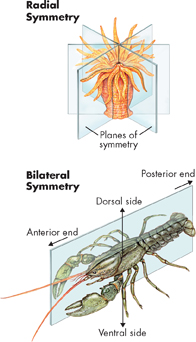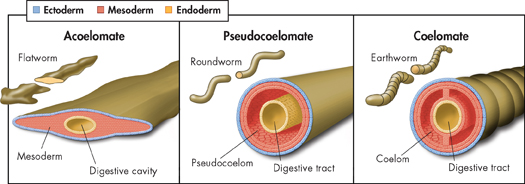Body Symmetry The bodies of most animals exhibit some type of symmetry. Some animals, such as the sea anemone in Figure 25–7, have body parts that extend outward from the center, like the spokes of a bicycle wheel. These animals exhibit radial symmetry, in which any number of imaginary planes drawn through the center of the body could divide it into equal halves. The most successful animal groups exhibit bilateral symmetry, in which a single imaginary plane divides the body into left and right sides that are mirror images of one another. Animals with bilateral symmetry have a definite front, or anterior, end and a back, or posterior, end. Bilaterally symmetrical animals also have an upper, or dorsal, side and a lower, or ventral, side. When you ride a horse, you are riding on its dorsal side.
Differentiation of Germ Layers During embryological development, the cells of most animal embryos differentiate into three layers called germ layers. Cells of the endoderm, or innermost germ layer, develop into the linings of the digestive tract and much of the respiratory system. Cells of the mesoderm, or middle layer, give rise to muscles and much of the circulatory, reproductive, and excretory organ systems. The ectoderm, or outermost layer, produces sense organs, nerves, and the outer layer of the skin.
Formation of a Body Cavity Most animals have some kind of body cavity—a fluid-filled space between the digestive tract and body wall. A body cavity provides a space in which internal organs can be suspended, and room for those organs to grow. For example, your stomach and other digestive organs are suspended in your body cavity. Most complex animal phyla have a true coelom (SEE lum), a body cavity that develops within the mesoderm and is completely lined with tissue derived from mesoderm. Some invertebrates have only a primitive jellylike layer between the ectoderm and endoderm. Other invertebrates lack a body cavity altogether, and are called acoelomates. Still other invertebrate groups have a pseudocoelom, which is only partially lined with mesoderm. Figure 25–8 summarizes the tissue structures of animals with and without coeloms.

FIGURE 25–7 Body Symmetry Animals with radial symmetry have body parts that extend from a central point. Animals with bilateral symmetry have distinct anterior and posterior ends and right and left sides.
dd
FIGURE 25–8 Body Cavities Acoelomates lack a coelom between their body wall and digestive cavity. Pseudocoelomates have body cavities that are partially lined with tissues from the mesoderm.
ddTable of Contents
- Formulas and Equations
- Applying Formulas and Equations
- Mean, Median, and Mode
- Estimation
- Using Measurements in Calculations
- Effects of Measurement Errors
- Accuracy
- Precision
- Comparing Accuracy and Precision
- Significant Figures
- Calculating With Significant Figures
- Scientific Notation
- Calculating With Scientific Notation
- Dimensional Analysis
- Applying Dimensional Analysis




